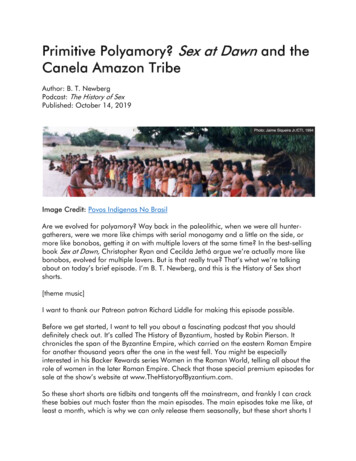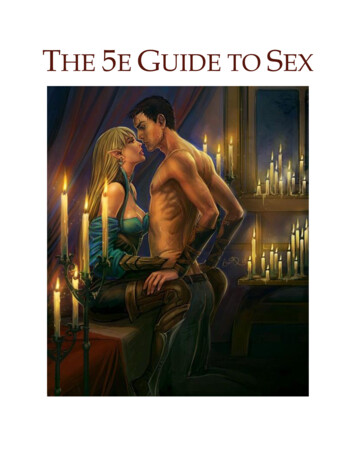
Transcription
Primitive Polyamory? Sex at Dawn and theCanela Amazon TribeAuthor: B. T. NewbergPodcast: The History of SexPublished: October 14, 2019Image Credit: Povos Indígenas No BrasilAre we evolved for polyamory? Way back in the paleolithic, when we were all huntergatherers, were we more like chimps with serial monogamy and a little on the side, ormore like bonobos, getting it on with multiple lovers at the same time? In the best-sellingbook Sex at Dawn, Christopher Ryan and Cecilda Jethá argue we’re actually more likebonobos, evolved for multiple lovers. But is that really true? That’s what we’re talkingabout on today’s brief episode. I’m B. T. Newberg, and this is the History of Sex shortshorts.[theme music]I want to thank our Patreon patron Richard Liddle for making this episode possible.Before we get started, I want to tell you about a fascinating podcast that you shoulddefinitely check out. It’s called The History of Byzantium, hosted by Robin Pierson. Itchronicles the span of the Byzantine Empire, which carried on the eastern Roman Empirefor another thousand years after the one in the west fell. You might be especiallyinterested in his Backer Rewards series Women in the Roman World, telling all about therole of women in the later Roman Empire. Check that those special premium episodes forsale at the show’s website at www.TheHistoryofByzantium.com.So these short shorts are tidbits and tangents off the mainstream, and frankly I can crackthese babies out much faster than the main episodes. The main episodes take me like, atleast a month, which is why we can only release them seasonally, but these short shorts I
can produce faster because they’re more free-form, more loose, and most of the materialis generated from the research of the main episode. So, here you go. I hope you enjoythem. Let’s get started.[music]So, I got the idea for our very first main episode, entitled What the Zombie ApocalypseTeaches Us About Sex, from a recommendation from Dan Carlin (that’s right, that’s aname drop!). When I interviewed Dan Carlin of Hardcore History for my other showDead Ideas (ya know, no big deal!), he said I should check out a book called Sex atDawn by Christopher Ryan and Cecilda Jethá – which I did, and which set my brain onfire. It’s an amazing book that I highly recommend, but which I also found can be wildlymisleading. So, I want to talk a little about that today.Now, before we really get into things, I want to draw a clear distinction betweenpolygamy and polyamory. Polygamy is an anthropological term for multiple spouses inmarriage, which most often manifests as one man, multiple wives. In contrast, polyamoryis a modern Western term for a certain kind of lifestyle. Modern polyamory is not justanything-goes wild abandon. Multiple sexual partners is certainly an important part ofpolyamory, but the other part is the willing consent of all parties involved. Trust is the trick.You can still be faithful and committed to a partner by upholding your promises to eachother, but those promises need not necessarily involve sexual exclusivity, in the opinion ofpolyamorists. So, it’s not just anything-goes. Rather, it’s a lifestyle, socially-sanctionedwithin the polyamorous community, that is or at least can be ethical.Meanwhile, according to polyamorists, jealousy is an emotion that each individual needsto work out for themselves, and believe it or not, there can even be a feeling calledcompersion. Compersion is the joy felt in seeing a partner happy and fulfilled with otherpartners. It’s analogous to the feeling felt by parents when their child gets married, or byyour best friend when you get married. And believe it or not, you can even feel bothcompersion and jealousy at the same time. Like a bridesmaid both happy and envious –beacuse we’re complex human beings, right? Pretty thought-provoking when you thinkabout it.That is how modern polyamorists tend to describe their lifestyle. So, what about primitivepolyamory? What about a system of multiple lovers among hunter-gatherers? Well, thekinds of relationships among hunter-gatherers we’re going to talk about today likewiseinvolve multiple sexual partners in a socially-sanctioned way. Now, mind you, values maybe quite different in other cultures, and that can make the “consent” aspect a little difficultto parse in some cases (and we will see an instance of that today), but we’re still talkingabout a lifestyle of multiple partners that fits within the bounds of a culture’s ethics.Now, the interesting question here is, are we evolved for this kind of lifestyle? That’s whatRyan and Jethá are getting at. So, above and beyond whether you can lead an ethicallifestyle like this, have we been specifically nudged toward it by evolution?
That’s where we can dive into our book. Sex at Dawn by Christopher Ryan and CecildaJetha made a big splash when it came out in 2001. Some of you may have heard of it,other’s maybe not. This is an amazing book that I highly recommend because it will lightyour brain on fire, but it is also wildly misleading in its presentation, as we will see. Andthat’s the main thing I want to talk about today. We’re not gonna come to any finalanswers about whether we are evolved for polyamory or not, but the main thing is I wantto present this book so that you can do the research on your own, and do it informedand in the right way.The basic premise of the book is: maybe we were evolved not for monogamy but forpolyamory. Ryan and Jethá don’t use the word “polyamory”, but they pretty clearly meana socially-sanctioned lifestyle involving multiple lovers, and not necessarily within thebonds of marriage, so “polygamy” doesn’t really cover it; it really feels more like they’retalking about a kind of polyamory for which they argue we might be evolved).The jumping off point is the fact that although we are normally thought of as being mostclosely related to chimpanzees, on the evolutionary tree we are actually equidistant withboth chimps and bonobos (our lineages diverged at roughly the same time, and we don’tknow exactly which one we descend from, so it could be either). Now, the key insighthere is that while chimps are monogamous with a little on the side, bonobos are straightup polygamous (they don’t have marriage, but in terms of mating). So, the thoughtseems to be: maybe we are evolved to be polyamorous, but developments sinceagriculture have forced us into a monogamous mold, and that’s why we have so muchdifficulty staying “faithful” to one another (faithful in the monogamous sense). Hmm.Interesting question.The problem is, Ryan and Jetha cherry-pick like they are at a cherry orchard, so that theirevidence to make it look like many pre-agricultural societies are unproblematicallypolyamorous, when that is in fact anything but the case. In fact, many of the tribes theytalk actually argue against their thesis once you get the fuller picture. And that’s the partyou need to be prepared for in approaching this book. So, let’s take a look at one ofthose tribes as an example: an Amazon tribe called the Canela.And looking at the Canela – you know, they are a fascinating people, so this will beworth the whole episode just in itself.So, here’s what Ryan and Jethá say about the Canela (this is on p. 120 of my copy of thebook, and it’s in the context of talking about marriage and virginity issues):Among the Canela, explain Crocker and Crocker [the anthropologists that they’re citing],viriginity loss is only the first step into full marriage for a woman. There are several othersteps needed before the Canela considers a couple to be truly married, including theyoung woman’s gaining social acceptance through her service in a festival men’s society.This premarital service includes sequential sex with 15-20 men. If the bride to be does
well, she’ll earn payments of meat from the men, which will be paid directly to her futuremother-in-law on a festival day.Done. That’s the whole paragraph that they give on the Canela. And just reading thatyou’re like, wait, what? Tell me more! Well, the only other place they talk about theCanela in their book is page 146, where they write:Anthropologist William Crocker is convinced that Canela husbands are not jealous,writing: “Whether or not they tell the truth about not minding, they join other members inencouraging their wives to honor the custom of ritual sex with 20 or more men during allcommunity ceremonies.And then Ryan and Jetha comment:Now anyone who can pretend not to be jealous as his wife has sex with 20 or more menis someone you do not want to meet across the poker table!In other words, they’re saying yeah, you’re telling me they just pretend not to be jealous?No, they’d have to be master deceivers. They’re just not jealous. That’s the point they’remaking: in this society, jealousy is not a problem.And if that were true, oh my god, wouldn’t that completely turn on its head yourconceptions about emotions and sexuality and everything about our species and how werelate one gender to another. That would be amazing.But is it really true? Let’s find out.As it turns out, an anthropologist named Lynn Saxon has written an entire bookenumerating all the things that Sex at Dawn gets wrong or presents misleadingly. Saxon’sbook is called Sex at Dusk, you can find it on Amazon. So let’s go now to Saxon’s bookand see what the Canela are really like.Saxon writes:“The Canela are a tribe living in a single circular village of about 1000 people. Femalesstay in their natal home, while males move to the home of their wife. Couples areinstructed not to be sexually jealous. Girls have their first sex between the ages of 11 and13, and the young male, perhaps 10 years older, that she has that first sex withautomatically becomes her husband. There are many steps she has to go through beforeher marriage is secure, the final one being the birth of a child.” (p. 120)Alright, so we already see that it’s a pretty different kind of sexual setup that this tribe hasgoing on here. Let’s continue:
“After a few months of marriage where the couple might not see much of each other, thegirl is then expected to accept sexual invitations from other men. After doing so, she isthen assigned along with another girl to a men’s society during a summer festival.” (p.120)Here’s what Ryan and Jethá must have been talking about.“.and is expected to allow perhaps as many as 25 men to have sex with her sequentially.She now wins her maturity belt, which after a brief period of seclusion, is painted by herfemale inlaws. Her role now is predominantly to provide sex to motivate men to work andbond. Sometimes she receives some meat from them or other small gifts for her femalekin.” (p. 120)Okay, so now I’m wondering how consensual all this is, but let’s go on and find out:“When a girl or woman does become pregnant and has sex sex during the pregnancywith a number of other men, these other men are also considered fathers, though withfewer obligations than the husband, to the child.” (p. 120)So, that’s a partible paternity belief, as we discussed in our main episode on sex andhunter-gatherers.“Male bonding within this single community is effected through quite severe training ofyouths, plus the bonding through sharing of wives, and sequential sex during summerfestivals with childless girls assigned to them for this purpose. Youths also go throughvarious internments, instruction, and discipline to train them for military-style obedience.Sex is actually the most effective means of social control, especially social control ofyoung men. The Canela were once fierce fighters, and their socialization andintergenerational authority is based on their need for military discipline. They do, though,have to be instructed not to be jealous. The loss of warfare led to youths no longersubmitting to control by the elders, and ultimately the male-male bonding and thesuppression of sexual jealousy broke down.” (p. 120)Huh. Okay. So, what’s that sex like, I wonder? Well, Saxon reports:“Crocker concludes, and I have to agree, that female orgasm does not occur. Themajority of the sex is for male gratification, and as masturbation is strictly forbidden forboth sexes, the fact that most sex lasts for a matter of seconds is perhaps not too difficultto believe. Canela sex involves no kissing and no touching of genitals. The man simplysquats between the legs of the woman who is not to move, his hands to either side of herbody for support.” (p. 120)So, what about, like. how consensual is this? Do these girls just accept this as part oftheir society? Do they look at it like a duty they have to perform although they don’t wantto? Do they ever actually refuse? What’s that like? Let’s find out.
“It is perhaps no wonder that girls and women might volunteer for sequential sex as it isonly after a series of short copulations that might actually experience some pleasure.About every other year, there is an occurrence where a girl will not agree to sequentialsex and so she is forced to comply by a group of men each having sex with her to “tame”her, basically a punitive gang rape. She knows she has no choice, and that even ifinjured, she will gain no sympathy. She has been raised to know what is expected of her,and that she will have to comply. She is also told that she may even come to enjoy it, andespecially to enjoy sex with a long-term lover in time.” (p. 120)Oof. Yeah, so by this point, with that fuller context, we’re getting a much better picture ofthis tribe. This is not a tribe of easy-going, free-loving hippie commune party-goers here.This is like a military installation of highly disciplined and highly sexually-repressedpeople who have these outlets that are highly restricted and duty bound.Yikes! That really turns on its head the argument that Ryan and Jethá were trying to makein their book Sex at Dawn.So, that’s the kind of thing you have to watch out for when you read a book like that.Again, I still highly recommend the book because it will set your brain on fire, but anabsolute must is to also read Lynn Saxon’s Sex at Dusk at the same time.By the way, I get nothing from either of these authors. This is not a sponsored plug. I justfound it interesting, so I’m passing it on to you.Now, to return to the issue of polyamory, what we just saw among the Canela you mightcall polyamory of a sort, but it’s a pretty far cry from the modern Western kind for whichconsent is a key tenet. I want to be clear about that.Nevertheless, the question remains whether we might be evolved for a multiple loverstype situation. For that, you’ll just have to check out these two books and decide foryourself. There’s a whole lot more presented as evidence that we don’t have the time toget into here. Suffice to say I’m not entirely convinced, and most experts in the field aren’teither, but it remains a fascinating question, which I just wanted to bring up to you here.Anyway, that’s our episode for today. I hope you do check out these books, just makesure you read both at the same time, so you can be informed you make up your mindabout whether we are evolved for polyamory.I’m B. T. Newberg, and I’ll see you next time for another of our short shorts.[music]
Podcast theme music mixed from tracks by Kevin MacLeod and “Short Shorts” by theRoyal Teens. For additional credits, references, pics, and more, see our website atwww.historyofsexpod.com.ReferencesBeckerman, Stephen and Valentine, Paul. Cultures of Multiple Fathers: The Theory andPractice of Partible Paternity in Lowland South America. Gainesville, FL: University ofFlorida Press, 2002.Ellsworth, Ryan. “Partible Paternity and Human Reproductive Behavior.” (Dissertation).University of Missouri-Columbia, 2014.Ryan, Christopher, and Jethá, Cecilda. Sex at Dawn: How We Mate, Why We Stray, andWhat It Means for Modern Relationships. New York: Harper, 2010.Saxon, Lynn. Sex At Dusk: Lifting the Shiny Wrapping from Sex at Dawn. CreateSpace,2012.Symons, Donald. The Evolution of Human Sexuality. New York: Oxford University Press,1979.Audio CreditsPodcast theme music mixed from “Gregorian Chant”, “Mystery Sax”, and “There It Is” byKevin MacLeod. Short Shorts theme music mixed from “Gregorian Chant” by KevinMacLeod and “Short Shorts” by the Royal Teens.Episode theme music: “Tikopia” by Kevin MacLeod
Oct 14, 2019 · for another thousand years after the one in the west fell. You might be especially interested in his Backer Rewards series Women in the Roman World, telling all about the role of women in the later Roman Empire. Check that those special premium episodes for sal










